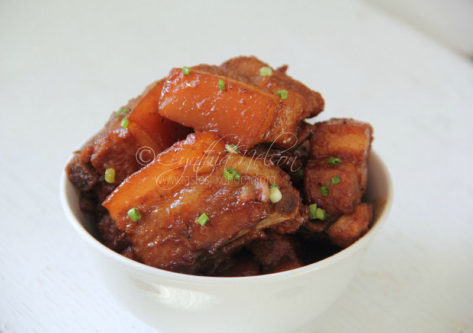Hi Everyone, What’s Cooking is a series in which I answer questions and share advice about food and cooking that you may have but are too shy to ask.
Have you ever cooked a stew, soup, or curry in a pressure cooker only to open the pot, the meat and other ingredients are perfectly cooked, but you find (as we say in Guyanese parlance), a whole set of long water? And then you have to let the liquid dry down, by which time, everything is so overcooked that it starts to fall apart and melt? If you answered yes, that is the topic of discussion today.

Before I go further, it is important to establish  what is pressure-cooking. We simply think of the pressure cooker as a pot that softens foods, particularly meats and rehydrated peas and beans; rarely do we think of the process involved in this type of cooking and what causes a pressure cooker to cook the food so quickly while tenderizing it. A quick glance at the manual would tell us, and we could avoid the headache and frustration of too much liquid in the pot and our food turning to mush.
what is pressure-cooking. We simply think of the pressure cooker as a pot that softens foods, particularly meats and rehydrated peas and beans; rarely do we think of the process involved in this type of cooking and what causes a pressure cooker to cook the food so quickly while tenderizing it. A quick glance at the manual would tell us, and we could avoid the headache and frustration of too much liquid in the pot and our food turning to mush.
Here’s what happens when pressure-cooking – steam builds up in the pot within a safe airtight environment, this build up is the pressure. The pressurized steam penetrates and permeates the food tenderizing it, resulting in faster cooking. When we cook in an open pot on the stove, notice how the steam rises and escapes? In a pressure cooker the steam is trapped in the pot when covered and the band of rubber around the lid seals the pot airtight. The intense pressure is built up so much that is raises the boiling point of the liquid and the cooking temperature. Eventually, all this pent-up steam needs to be set free. The release comes when the knob at the top of the pressure cooker rises and gives off loud bursts of hisses (Hawkins) or a constant, rhythmic hiss (Futura). To put it simply, pressure-cooking is when steam is trapped in the airtight pot raising the cooking temperature resulting in tenderizing the food, thus facilitating faster cooking. Got it?
Because things cook faster in a pressure cooker, it automatically means that we do not need to put in as much water in the pot as we would if we were cooking in a regular pot on a stovetop. As a guide I generally use half the amount of water I would if I were cooking on the stovetop. In other words, if a recipe called for 1 litre (US 4 cups) of water, to cook on the stovetop, I would only use 2 cups of water if I were preparing the same recipe in a pressure cooker. However, this guide gets altered depending on which of my pressure cookers I am using based on the material with which the pressure cooker has been made. For example, if I am using one of my aluminum or stainless steel Hawkins, I half the liquid but if I am using my Futura, I reduce the water even more. The Futura pressure cookers are made of hard anodized material that absorbs heat faster cutting down further on cooking time. If after the stated cooking time I open the pressure cooker and there is still too much liquid than I would like (and this happens sometimes), remove the cover from the pot and turn the heat to high to quickly reduce the liquid, letting the steam escape; that is the best way to deal with the situation. Some people make the mistake and relock the pressure cooker, bringing it back to pressure, and turning the heat to high thinking that that will reduce the liquid. It won’t. Well, it would, eventually; there is very little evaporation in pressure-cooking hence the need to use a reduced amount of liquid to cook. If you choose to pressure your way out of the long water situation, the prolonged pressure-cooking will shred or melt your food depending on what you are cooking. Remember, pressure-cooking is cooking with trapped steam.
Once you’ve added all the ingredients (including liquid) to the pot, cover/close it until steams starts to escape from the vent at the top, then put on the knob, it will take about 2 minutes or more to come to full pressure. When the pot comes to full pressure, you need to reduce the heat to cook the food. If the pot is cooking on high heat reduce it to medium, if it is on medium, reduce it to low. This lowering of the heat is also one the main reasons that less water should be added to the pot. When the pot comes to full pressure and the heat is reduced, the pressure is maintained so that the food cooks quickly. If you find when you lower the heat that the cooker is whistling often, like more than 4 times per minute, the heat is too high, lower it. On the other hand, if there is no steam/whistling, increase the heat a little until the steam starts to escape. Start timing your cooking when the cooker comes to full pressure – at the first whistle or when the high constant hissing begins (Futura).
A pressure cooker is a “smart” pot and if you listen to it, you will know when you have added too much liquid or not enough. You will also know, when the liquid is drying down in the pot. When the knob raises itself to release steam, but instead of steam alone emanating, it starts to choke up and spit liquid, it means that there is too much liquid in the pot. To remedy the situation, remove the pot from the heat, cool it down by placing the bottom of the pot in a pool cool tap water to lower the temperature so that you can release the steam and open the pot. At this stage, you can remove the excess liquid and reserve it in case you will need to add it back later (depending on what you are making), or you can put the pot, uncovered, over high heat and let it boil until it has reduced at least by a third and the cover the pot again to bring it back to pressure.
As liquid reduces in a pressure cooker, the duration of the whistle/high hiss will shorten. The longer the burst of the whistle, it says there is good enough amount of liquid to create steam, however, if the whistles are short and frequent, the liquid has significantly reduced and will dry out soon. When this happens, shut off the heat and release the pressure to open the pot. If the food is not finished cooking, add a little boiling water to the pot and continue to cook, covering and bringing the pot back up to pressure.
I have found that with the Futura, it is a little trickier to determine where the liquid level is at because there is no whistle, just the constant hiss. However, if you listen carefully, you can hear the rhythm of the hiss slow down as the liquid dries out.
When cooking certain dishes, say Cook-up Rice, which is often made up of a combination of meats, plus rehydrated beans and peas, you have to stagger the cooking of the ingredients. For example, let’s say we are making Cook-up Rice with tripe, fresh beef and salted pork with black eye peas. We know right away that we cannot add the salted pork the same time to the pot with the tripe, nor can we add the black eye peas – both ingredients would completely disintegrate by the time the tripe is done cooking.
Always start with the ingredient that takes the longest to cook and work your way down to the ingredient that takes the least time to cook. As a rule, I always add enough water at the onset to cook all the meats and peas, that way, as I open the pressure to add ingredients, I do not have to add more liquid resulting in the pot taking longer to come back to a boil, and pressure.
Timing is key when staggering the cooking of various ingredients. Let’s say the total time for the tripe to tenderize would be 30 minutes (pressured), the beef 15 minutes and the pigtails and peas 5 minutes. I would start by pressuring the tripe for 15 minutes, open the pot and add the beef, and 10 minutes later, add the pigtails and peas and cook them for 5 minutes. When the time is added up: 15 + 10 + 5, it will give me a total of 30 minutes. The combination of ingredients will be cooked, tenderized and yet remain intact with only the rice, coconut milk and seasonings to be added. There are times also (and with practice you will know to do this as well), that I undercook certain ingredients for Cook-up Rice in such a way that by the time the entire dish (rice, coconut milk etc. added) is finished cooking, that ingredient is done cooking too.
Finally, you cannot over fill your pressure cooker with solids and liquids almost to the top of the pot and expect it to perform well or to pressure at all. I strongly advise that you read the manual of your pressure cooker because the level to which the ingredients must be will vary from one cooker to the other depending on the size and material with which it has been made. Some cookers have markings on the inside that indicate the maximum level at which you can fill the cooker. There must be enough room in the cooker for the steam to circulate and permeate the food, enabling tenderization and fast cooking.
Armed with all of this information, what are you going to cook in your pressure cooker this weekend? A pot roast for Sunday lunch would be perfect. Season the meat overnight. Brown the meat all over in a pan or directly in your pot if it is large enough, add some boiling water (the amount would vary depending on the type of cooker you are using and the size of the meat). For a 5 to 6-pound pork shoulder roast I’d say go with 2 ½ to 3 cups of water so you’ll have a little sauce when it is done. Cover, let steam escape then put on knob, bring to full pressure, cook on high heat for 5 minutes, reduce heat to low and cook for 25 minutes. Remove pot from heat, release pressure, open the cooker and return to heat letting the sauce thicken if it hasn’t. Let meat rest for 15 minutes before removing and cutting.
Enjoy.
Cynthia








